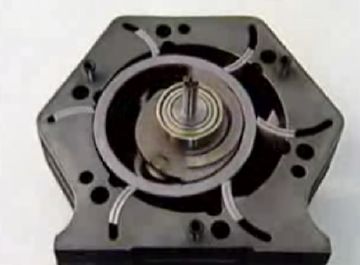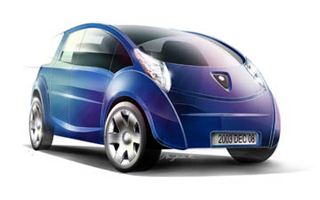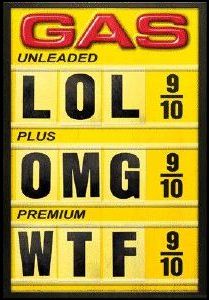Archive for March, 2008
Another Air Power Innovation

EngineAir, of Melborne, Australia has invented a 13kg rotary air motor that will replace traditional combustion engines. Unlike the ZPM approach of using a standard piston/cylinder setup, this is a departure from traditional automotive engine design (Mazda’s combustion rotary engine has been around for awhile, but it’s far from mainstream.) This breakthrough was made by Angelo Di Pietro in 1997.
Unlike other companies, EngineAir doesn’t seem to have secured significant funding and thus has not published a production schedule for vehicles using their technology. However, if compressed air is going to be viable as a fuel, it seems to us that an approach like EngineAir’s design is more likely to be the longer-term solution than simply repurposing the cylinder/piston design.
One Air Car

Zero Pollution Motors is designing a set of air powered cars for release in the US. That’s right, these vehicles use compressed air (and at speeds over 35mph, small amounts of fuel mixed with compressed air) to power a 6 seat vehicle over 800 miles on 8 gallons of fuel plus the compressed air. The air is stored in on-board carbon fiber tanks that have the tendency to rip rather than explode on impact. This is important as the pressure being held in each vessel is in excess of 300 bar. Wow. That’s going to be tough to handle!
ZPM has been garnering a bunch of press lately on the heels of their recent announcement with Tata Motors of India. An interesting concept to be sure.
Green DIY Electric Motorcycle
We thought highlighting a “green motorcycle” would be a great way to celebrate St. Patrick’s Day. Watch the video below to see an interesting project (the music is a little over the top, you might turn down the volume if that sort of thing bothers you.)
This is a great project and a great way to recycle old vehicles. We love to see activities like these as it provides some hope that people will actually find ways to help innovate out of our present crisis, dependency on foreign energy. Think of a local transport like this charged in a distributed manner…that could be very high impact. Now, if an individual can do this for less than $3,000, why can’t a vehicle manufacturer pull it off?
- D&D SepEx Motor (about 45 ft-pd torque at 2000rpm)
- 400 Amp Alltrax Controller with PC link
- Four 12 volt deep cycle marine batteries (Wal-Mart)
- Four on-board battery chargers
- 6:1 gear ratio
The bike has a top speed of 45mph and a range of about 30 miles. Operating cost appears to be in the range of $0.02/mile.
2 comments
A Live Tesla
Last night, one of our partners was in Palo Alto for an unrelated event and bumped into a real, live Tesla on the street. Apparently, there was some sort of Tesla party at the Blue Chalk Cafe – it was quite the event. But it was nothing compared to the car, wow. It’s compact, it’s sleek, and we want one. For your viewing enjoyment, here’s a picture of a live production Tesla Coupe.

Tips for Fuel Efficiency
As the price at the pump continues to rise, the transportation segment looks for more ways to reduce cost of fuel. It is possible that there are a few very simple things we can do that will reduce our gasoline consumption by as much as 10%. Most are simple, most are common sense, and most are very inexpensive. Here are some simple ideas to increase fuel efficiency:

- Remove Unnecessary Mass – Each reduction of 45kg (100lbs) will increase fuel efficiency as much as 2%. One of our partners observes “Another good reason to diet.”
- Proper Tire Inflation – This simple item can increase fuel efficiency as much as 3%. Even if you must pay for air, you’ll get a return on your investment.
- Tune Up – Having the right grade and fresh motor oil along with a clean air filter can increase fuel efficiency as much as 5%.
- Drive Sensibly – Interestingly, the thing that is right in our control is the thing that we least frequently do. Drive the speed limit, avoid hot rod starts and stops, and try to use your brakes as little as possible. Depending on your driving technique, this can yield 5-33% better fuel economy.
- Combine Trips – This pre-planning makes it possible to reduce overall driving and fuel demand.
- Don’t Idle – Any stop longer than a traffic light and you should consider switching your engine off; idling simply burns fuel with no forward momentum.
- Alter the Commute – There are several ways to do this including biking to work, taking public transit, telecommuting, and even shifting your work schedule to spend less time simply sitting in traffic.
Try some or all of the techniques above and see how your fuel efficiency changes. Most importantly though, measure your consumption. Before you change anything, establish a baseline consumption level, once that is calculated, make one change and observe the result. Then make the next change and observe the result. In this way, you can make a 10% difference and know which items have the most impact in your situation.
Thanks for dropping by, you can also save money by replacing your old incandescent bulbs with compact fluorescent. We’ve got real data on electricity consumption before and after switching out the 83 of 95 bulbs in one home. Think it’s pennies? You’d be surprised, we’re on track for a $4,100 savings – $600 better than our initial projections.








